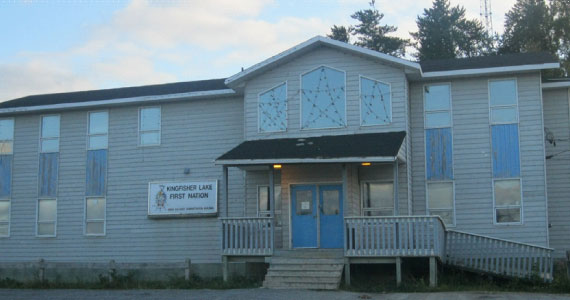Kingfisher Lake First Nation
About Us

The Aboriginal homeland which surrounds the present reserve site of the Kingfisher Lake First Nation has ways been utilized and carefully preserved by local first nations people as their personal heritage. The rights to culture, fishing, gathering, hunting, language and trapping were granted to the first nations people by the great creator. Thus, as the original stewards of the lands in which their ancestors lived, the current residents treat this responsibility with great care and respect.
History
In 1808 the Hudson's Bay Company established an outpost at Big Beaver House, which is located approximentely 12 kilometres southwest of the present Kingfisher Lake reserve. Big Beaver House was frequented by Kingfisher Lake people for trading fur, community activity and freight hauling employment.
During 1929 -1930 the leaders of Kingfisher Lake First Nation were required to gather at Big Trout Lake and participate in the siging of the adhesion to Treaty Number 9. As the result of this document, Kingfisher Lake was consider a part of Big Trout Lake Band.
In 1947 the Ontario Government enacted the trapline registration and fee program which eventually forced the Kingfisher Lake people to outline their ancestral hunting areas into trapping boundries and also to pay for the land use requirements.
In 1964 the leaders of Kingfisher Lake decide to establish permanent community and moved to the current location of the reserve lands. As Kingfisher Lake was already included in the Big Trout Lake Band and thus had reserve status, formality of gaining band status was achieved in 1975.
In 1984 Kingfisher Lake band along with several other neighbouring first nations agreed to form the Shibogama First Nation Council through a legal corporation.
Location
Kingfisher Lake is situated within the Sioux Lookout administrative district.
Latitude 53 5'N
Longitude 89 49'W
350 km Northeast of Sioux Lookout
40 km West of Wunnumin Lake
Populations
The current population figurs of the first nation is 411 residents.
Accessibility
The predominant travel mode to this community is through air transportation, however, on seasonal basis one can access this reserve using winter trails, winter road and waterwys. Kingfisher Lake can not be accessed through provincial highway, nor is there any roads connections with nerby reserve.
Natural Evironment
Kingfisher Lake is surrounded by large variety of wildlife, aquatic life, vegetation and certain mineral deposits. These natural resources have benefited the first nation people both personally and commercially. At the moment there is no major development of any mineral deposits in the area.
Climate
The local weather is generally affected by the air masses and eather systems that originate over the large land mass to the west, north, and south. Mean temperatures are -25c to -20c (winter) and 11c to 18c (summer).
Language
The first language of Kingfisher Lake is termed Oji-cree, which is a mixture of cree and ojibway. Developments have been established to ensure that the native language is retained. More then half of the community are able to communicate in english fluently.